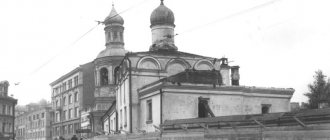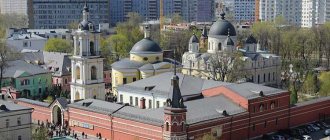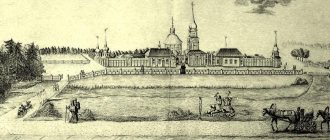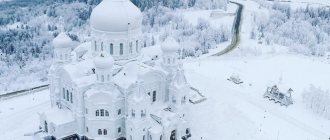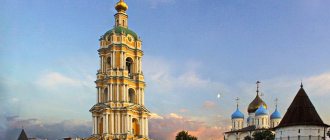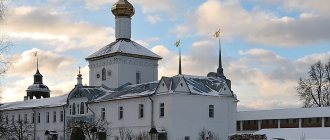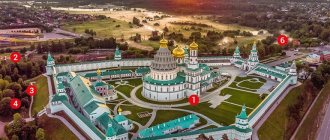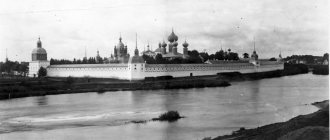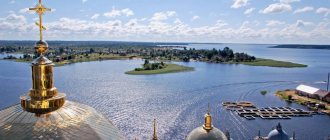This year the Donskoy Monastery in Moscow celebrates its 430th anniversary. On the Day of Remembrance of the “namesake” of the monastery - Grand Duke Dmitry Donskoy, we remember the story that connected two iconic names for Russia.
Subscribe and read Express Newspaper in:
In 1380, the Moscow prince Dmitry Ivanovich defeated the troops of the Golden Horde of the beklyarbek Mamai on the Kulikovo field (now the Tula region). “Like rain from a cloud, the blood of both Russian sons and the filthy ones poured down, and countless numbers fell dead on both sides,” the chronicle says.
In battle, the Russians were protected by the Don Icon of the Mother of God, with which the wonderworker Sergius of Radonezh blessed the prince. 200 years later, in 1591, the Horde again got punched in the teeth. Tsar Theodore Ioannovich defeated the Crimean Khan of Gaza II Geray . In memory of this event, a monastery was built in Moscow, where the intercessor icon was transferred.
Icon of the Mother of God
Icon of the Mother of God
- Image type: Eleusa (Tenderness) - Mary and God the Son are as close to each other as possible. This is a sign of the expression of the Creator’s supreme love for man.
- Creation: 1382 - 1395
- Artist: Theophanes the Greek or his student.
Icon of the Mother of God
They say that the icon was presented to Prince Dmitry Ivanovich by the Don Cossacks, who arrived to fight the Mongol-Tatars. But, according to experts, it was written later. On the reverse is the Assumption (death) of the Virgin Mary. The list of gold jewelry, stones and pearls on the frame took up three pages. In 1812, Napoleonic soldiers stole the jewelry. After 1917, the silver chasuble also disappeared.
Holy Prisoner
In 1918, the monastery was officially closed, but monastic life glimmered in it for several more years, although anti-religious exhibitions were already held on the territory and an anti-religious museum was opened.
In the building of the former guardhouse, which is adjacent to the northern gate of the monastery, since 1922, St. Tikhon, Patriarch of Moscow, was kept in custody. Almost until his death, he lived in two cramped cells under the constant supervision of Komsomol members. Going out onto the monastery wall, the saint could communicate with the flock standing below through the lattice fence. There were repeated attempts on the life of the saint. During one of these attempts, in 1924, Yakov Polozov, the Patriarch’s cell attendant, was killed. When the killers climbed the wall, Yakov came out to meet them and, taking three bullets, defended the patriarch at the cost of his life. The saint insisted that Polozov be buried on the territory of the monastery. His grave is now located near the southern wall of the Maly Donskoy Cathedral.
Saint Tikhon died six months after these events, on April 7, 1925, in a hospital on Ostozhenka. His last words:
“The night will be dark, long... Long...”
The Patriarch-Confessor was buried in the Donskoy Monastery by all Orthodox Moscow. But over 70 years of persecution, his burial place was lost. Only a few years after the glorification of the saint, in 1989, his incorruptible relics were miraculously found - the burial was discovered by accident during repair work after a fire in the Small Cathedral. Now the shrine with the relics of St. Tikhon is in the Great Cathedral, to the left of the Royal Doors.
In the house where the holy patriarch lived, in his cell, it is planned to create a house-museum. Already now it contains the remaining incorrupt vestments in which he was buried, photographs, documents, and personal belongings.
A museum of Patriarch Tikhon is being created in the monastery. Already now it stores documents, photographs, and personal belongings of the patriarch. It is not yet possible to open wide access to the museum - the monastery does not have enough funds to purchase expensive museum equipment that could help preserve unique exhibits. In 2011, the monastery turns 420 years old. Perhaps there will be philanthropists who will donate money for the creation and opening of the St. Museum for visitors. Tikhon to this date. Fully equipping the museum with equipment will cost only 30 thousand euros. Photo from the museum archive: St. Tikhon in a trench during the First World War
Ovens of Auschwitz in Moscow
After Lenin's death, they planned to embalm his body until the Moscow crematorium was completed. The burning furnace was installed in the Church of St. Seraphim of Sarov at the New Donskoy Cemetery. The equipment was ordered from a German company. Engineer Kurt Prüfer . On December 29, 1926, the furnaces were launched. The idea of cremation was widely advertised. The society of cremation lovers included honorary members - Stalin, Molotov and Kalinin . In 1930, the guidebook “Godless Moscow” reported: “The Donskoy Monastery is a pioneer in the area of cremation in the USSR” and “only in the USSR is cremation available to everyone.” And in 1940, a furnace operator at a Moscow crematorium fanned the hellish flames at Auschwitz. After the war, Kurt received 25 years in the camps and disappeared in the vastness of the Union.
Donskoy Monastery in Moscow
Abbots, governors
- Gury (mentioned 1598)
- Sergius (mentioned 1621)
- Euphrosynus (? - 1634) dismissed
- Theodosius (May 1, 1634 - mentioned 1635)
- …
- Athanasius (November 30, 1678 - February 1681)
- Gerasim (mentioned June 1682)
- Leonty (mentioned June-July 1683)
- Nikon (August 1683 - June 1689)
- Anthony (Odinovich) (mentioned 1692 - mentioned 1697)
- Arseny (Kirillov) (mentioned July 1, 1697 - ?)
- Afanasy (mentioned 1853)
- Paul
- Arkady (Yatsenko) (1862 - 1869)
…
- Nikon (Purlevsky) (1918 - 1919)
- Agathodor (Markevich) (1991 - December 25, 2009)
- Kirill (Pokrovsky) (December 25, 2009 - July 26, 2012)
- Paramon (Dove) (July 26, 2012 - February 26, 2019)
- Foma (Demchuk) (February 26, 2021 - August 25, 2020)
- Evgeny (Kulberg) (August 25 - December 8, 2020)
- Feognost (Guzikov) (from December 8, 2020)
Miro's house
The Small Cathedral (1591 - 1593) is the first building designed by the architect Fyodor Kon . Here, even today, holy myrrh is brewed - oil for the sacraments of anointing and consecration of churches. The oil contains premium quality olive oil and 30 other components: incense, mastic, thyme, ginger and violet root, cardamom, aromatic oils - nutmeg, rose, lavender, cloves, lemon. However, the exact recipe is kept secret. The procedure for making peace is a sacred rite: the oven is covered with a cloth, containers with ingredients are sprinkled with holy water, and the firewood is lit with a trikiriy - a candlestick with three long candles. They cook without stopping for the first three days of Holy Week.
Archbishop Theognostos. Photo © ITAR-TASS
Donskoy Monastery and its formation
Donskoy Monastery is one of the oldest monasteries in the city of Moscow, founded by Tsar Theodore Ioannovich in 1591-1593.
in memory of the city’s deliverance from the attack of the Crimean Khan Kazy Giray. The monastery was founded on the site of a camp church in honor of St. Sergius of Radonezh, in which the icon of the Don Mother of God was located.
According to legend, this was the same icon with which St. Sergius blessed Grand Duke Dmitry Ioannovich for the battle that took place in 1380 on the Kulikovo field, near the Don. In honor of that great victory, the people began to call the icon Donskoy (like the prince himself). This is how the monastery got its name.
Gentlemen officers
In the fall of 2005, the remains of participants in the White movement were reburied in the monastery. General Anton Denikin and philosopher Ivan Ilyin and their wives were transported from the USA, France and Switzerland, and General Vladimir Kappel later from China. Vladimir Putin himself proposed creating a memorial to the White Guards , who laid flowers at the tombstones on May 24, 2009. According to Archimandrite Tikhon , the president changed his attitude towards Denikin after reading his diaries, where the general wrote that with all his intolerant attitude towards Soviet power, even thinking about the dismemberment of Russia is a crime.
How to get to the monastery
The monastery is located 5.5 km south of the Moscow Kremlin. The monastic territory is 1.1 km from the Shabolovskaya metro station, 1.5 km from Leninsky Prospekt and 2 km from Tulskaya. Trams No. 14 and 39 stop nearby. You need to get off at the “Peoples' Friendship University” stop. In addition, the entrance to the monastery can be reached on foot from Leninsky Prospekt - from the public transport stop “Institute named after. Kurnakov."
Attraction rating
Rating 5.00 [1 Vote]
| ← MONASTERIES OF MOSCOW | MOSCOW → |
Donskoy stauropegial (that is, subordinate only to the patriarch) monastery
- Area: 7 hectares + 1226 hectares of farmstead in the village of Knyazevo (Ryazan region), where vegetables and berries are grown
- Population: 21 monks and 9 workers
- Shrines: Don Icon of the Mother of God, relics of St. Tikhon.
Great Cathedral (cathedral church in honor of the icon of the Mother of God, called Donskaya)
- Erected in 1683 - 1698.
The main architectural treasure of the monastery. Here is the tomb of the Georgian princes and princes Dadianov and Bagrationov . According to Georgian tradition, gravestones are laid flush with the ground so that they can serve people even after death. The heads of the church are oriented to the cardinal points. Inside is a unique seven-tier iconostasis.
Church of John Chrysostom and the Great Martyr Catherine
- Erected in 1888 - 1891.
A neat, elegant church in pastel colors. Built in the Byzantine style, like traditional Greek temples. This is how it was conceived in 1888 by the architect Alphonse Vincent , who worked a lot in Crimea.
Necropolis, or Old Cemetery
Princes and princes, boyars and nobles, the richest merchants and heroes of the war with Napoleon . Relatives of Leo Tolstoy , Pushkin , Turgenev ... “Maid of honor at the court of four emperors” with a beard grown in old age Natalya Golitsyna , who inspired Alexander Sergeevich for the image of the Countess from “The Queen of Spades”. The oldest graves are from the beginning of the 18th century. Today they bury people in exceptional cases. On August 6, 2008, the grave of Alexander Solzhenitsyn .
Western Gate (with a gate church in honor of the righteous Zechariah and Elizabeth)
- Erected in 1730 - 1753.
Senator and cousin of Peter the Great Alexander Naryshkin donated 100 pounds of iron for the construction. But there were not enough funds, and construction was delayed. Today there is a gold-embroidery workshop inside, where church vestments are sewn.
Holy (northern) gate with a gate church in honor of the Tikhvin Icon of the Mother of God
- Erected in 1690, 1713 - 1714.
The main entrance to the monastery. In 1922, Moscow Patriarch Tikhon . On December 9, 1924, three unknown people broke into his former apartment. Cell attendant Yakov Polozov was shot at point-blank range.
Towers and walls
- Erected in 1686 - 1711.
There are 12 towers in total. The walls seem impregnable; there is a gallery inside to move around the perimeter. But by the time of construction, Moscow did not suffer from raids. The thickness of the walls is not military grade.
Temple of St. George the Victorious
- Erected in 2000.
The temple is small and the youngest. Built on the site of former monastery gardens. Nearby there is a pond used for watering and breeding fish.
Abbot's Bath
- Erected in 1750.
After the revolution, the building was used as a residential building, and since the 1980s it has housed the museum's funds.
Fraternal Corps
Small Cathedral
Along the walls of the monastery are preserved marble bas-reliefs of the Cathedral of Christ the Savior, which was blown up on December 5, 1931. Photo by Ruslan Voronoi
Founding of the monastery
In 1591, the army of the Crimean ruler, the powerful Kazy-Girey, approached Moscow itself. The city was ready for defense, but its residents were preparing for the worst. By order of the Russian sovereign Fyodor Ioannovich, a crowded religious procession was held around the capital. And the tsar sent the defenders of the city the famous icon of Our Lady of the Don, which, according to legend, was with Dmitry Donskoy during the famous Battle of Kulikovo.
Then there were several local skirmishes between Russian warriors and Tatars, however, the decisive battle never took place. The Tatar troops camped for several days and, unexpectedly for everyone, turned back.
The amazing rescue of Moscow caused universal joy and rejoicing. In honor of the great miracle, the Russian sovereign ordered the founding of a new monastery. And the place chosen for it was the territory of “Gulyai-Pole”, where the mobile army that met the Tatars was located.
The Battle of Kulikovo took place on the church holiday of the Praise of the Mother of God, so the new monastery was first dedicated to the Mother of God.
View of the towers and walls of the monastery from the street. Donskaya
Intercession from above
In the 1920s, the cemetery of the Spaso-Andronikov Monastery was closed. The grave of the industrialist Yasininsky, together with the monument - the figure of Christ made of black labradorite stone - was moved to Donskoye. During the Great Patriotic War, soldiers' mothers asked Jesus for intercession. Since then, the toes of the sculpture have been polished to a shine. There are stories that at night Christ wanders between the graves, blessing the dead.
The grave of the industrialist Yasininsky. Photo by Ruslan Voronoi Sergey Korneev
#22/2021 Temple
